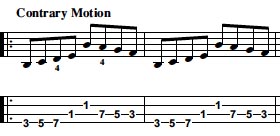« Pencils for All Musicians |
Main
| Best of JM: Fretboard Geometry »
 September 4, 2014 | Best of JM: Turning scales and arpeggios into music September 4, 2014 | Best of JM: Turning scales and arpeggios into music
Enjoy the popular archive material below.
From September 29, 2011 | Turning scales and arpeggios into music
Teachers of of beginning musicians will tell you practicing scales and arpeggios are crucial to learning how to play music. Teachers of advanced musicians will tell you practicing scales and arpeggios teach you how to sound like you're playing scales and arpeggios...
We're big on conquering these fundamental ingredients, scales, modes, and breaking chords into linear melody, but there's no question you can't stop there. This skill is merely a jumping off point, an ability that makes you more efficient in the aesthetic process of improvising and creating your own music. So how do you NOT sound like your playing scales in your solo? Here are a few tricks up your sleeve, and we suggest you implement this into your own practice routine. Don't just play a scale. Once you get it into your fingers, try altering it in some of these ways.

Reverse course. Bottom note G, High note G, and all the notes of the G Major scale in between. You ascend, then you descend. Sounds great, but how many times does this incarnation of the scale happen in real music? If you really want to master a major scale, try starting on the top note, descend, and then ascend again. Guarantee this is a new skill and somewhat uncomfortable if you haven't tried it before. Still, this is what happens in "real life," so practice this way once in a while.

Start in the middle. Next step to this altering direction is to alter the starting point. Try starting from the 3rd scale degree and play up, down and back. Again, this is real life. Start on the 5th scale degree. Rarely does a passage of music starts on the first note of a scale, so once in awhile you should practice this way.
Break it up. In our FFcP studies we practice broken 3rds and 4ths, another good way of playing a scale--without sounding like a scale.

Syncopate the harmonic rhythm. When you start a scale on the tonic, at least the first half of the scale as you playing 1, 3, 5, on the strong beats, which outlines the chord on the strong beats. If you started on 2 instead, and went, 2, 1, 2, 3, 4, 5, etc., you'd have the 1, 3, 5 chord on the upbeats. The end result is harmonic rhythm "syncopation." It's a nice effect you should plug into your solos.
Add chromatic leading tones. Determine a staring note of the scale, but precede it with a half step (up or down) leading note. For example, lead into a Bb Major Scale with a single Ab. Ornamenting your scales in this way conditions you to solo with more creativity. Playing the blues in G, you could precede any D with a Db. Instant blues!
These are great spice "condiments" to add to the culinary routine of practice. See how musical you can make a vanila scale routine sound.
Further:
Approaching Improvisation
Improvisation: Pattern Based VS. Theory Based
Critical Decisions in Improvising: 'Gravity' Notes
Suspicion of Melodic Intent
Spelling out the chords melodically
Posted by Ted at September 4, 2014 9:01 PM

Disclaimer: In the 'Information Age' of the 21st Century,
any fool with a computer, a modem, and an idea can
become a self-professed 'expert." This site does not
come equipped with 'discernment.'
|



